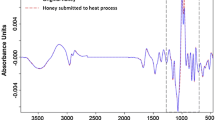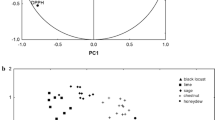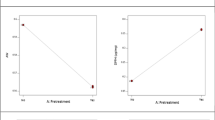Abstract
According to Box–Behnken design, 17 runs with five replicates were used to study the combined effect of temperature (60 to 80 °C), time (10–15 min) and pH (3–6) on the antioxidant properties (DPPH-radical scavenging activity (DPPH-RSA), TPC-total phenolic content and TFC-total flavonoid content) of saffron honey by employing response surface methodology. The statistical analysis showed that all three process variables significantly affect all the three responses. There was a statistical significant (p < 0.05) increase in all responses (DPPH-RSA, TPC and TFC) with the increase in time and temperature which resulted in increase in antioxidant activity. The antioxidant properties of saffron honey were significantly (p < 0.05) decreased with the increase in pH from 3 to 6. The results established that antioxidant activity was increased with the formation of browning pigments.
Similar content being viewed by others
Explore related subjects
Discover the latest articles, news and stories from top researchers in related subjects.Avoid common mistakes on your manuscript.
Introduction
Honey is a natural sweet and complex liquid formed by honeybees which is extensively rich in phytochemicals [1]. The polyphenols responsible for antioxidant activity mainly including flavonoids (hesperitin, apigenin, chrysin, quercetin, luteolin, pinobanksin, galangin, myricetin, pinocembrin, kaempferol, etc.) and phenolics acids (caffeic, ellagic, chlorogenic, cinnamic, benzoic, ferrulic, vanillic and coumaric acids) have been found in most of the honeys around the world [2, 5]. Besides polyphenols, Maillard reaction products, enzymes (catalase, peroxidase and glucose oxidase), carotenoids and vitamins (C and E) also contribute antioxidant effect to honey [2, 4]. The antioxidant activity of honey is influenced by floral origin and geographical origin while the effect of processing, storage or environmental factors have less contribution on antioxidant activity of honey [2, 3, 6]. Therefore honeys from different sources and regions differ in their antioxidant activity.
The Response Surface Methodology (RSM) is a set of statistical and mathematical techniques useful for determining the effects of response factor and the interactions among them. RSM is a faster and more efficient method for assembling research results than the classic one-variable at a time or full-factor experimentation. For a good fitted model, the coefficient of determination should not be <80 %. A higher value of R2 close to unity indicated that the empirical model is suitable for fitting the actual data while a lower value of R2 means that the model is inappropriate for explaining the relation between variables [7, 8].
Although raw honey is considered good for health, this product normally undergoes processing to remove bee wax, pollen and other extraneous matter to make it marketable and consumer approval. The honey is also subjected to thermal treatment mainly to prevent or delay crystallization and to destroy sugar tolerant yeasts that may cause unnecessary fermentation [9, 10]. During thermal treatment, honey losses most of its natural antioxidants which can be compensated by the formation of non-nutrient antioxidants like Maillard reaction products (MRPs) [11, 12]. Wang, Turkmen and coworkers [13, 14] have studied impact of heating at different temperatures on antioxidant activity of honey but no literature is available on combined effect of time, temperature and pH on antioxidant properties of any honey type around the world. Thus, the aim of this work was to study the effect of time, temperature and pH on antioxidant activity of saffron honey from Kashmir valley of India by using response surface methodology.
Materials and methods
Chemicals and reagents
All chemicals, solvents and reagents were of analytical grade. Methanol, acetic acid, Folin–Ciocalteu reagent, 2, 2-diphenyl-1-picrylhydrazyl (DPPH-RSA), aluminium chloride, sodium acetate (trihydrate) and Sodium carbonate were purchased from Fluka Goldie, Mumbai, India.
Honey sample collection and pollen analysis
The samples of saffron honey (Crocus sativus) were collected from local beekeepers and packed in glass bottles before storing at 4 °C under refrigeration condition. The origins of saffron honey samples were confirmed by microscopic pollen analysis. Honey samples were classified according to their botanical origin using the method described by Von der Ohe and coworkers [15]. The following terms were used for frequency classes: predominant pollen (>45 % of pollen grains counted), secondary pollen (16–45 %), important minor pollen (3–15 %) and minor pollen (<3 %).
Heat treatment of honey
The thermal treatment of honey was performed at different temperatures (60–80 °C) for different time periods (10–15 min) with different pH values ranging from 3 to 6 using acetate buffer solutions (0.1 M of sodium acetate and 0.1 M of acetic acid). The honey samples, weighed in small glass containers were sealed with rubber stoppers and were placed in a water bath at desired temperature. A thermocouple was also placed in the sample to monitor its internal temperature. The desired time period was noted once the internal temperature reached at the desired temperature. The sample was then transferred to an ice bath and cooled to 20 °C. The samples were analysed in duplicate for TPC, TFC and DPPH radical scavenging activity (DPPH-RSA).
Determination of total phenolic and total flavonoid content
The TPC present in all honey samples were determined by using the Folin–Ciocalteu method. The TPC was determined by comparing with an analytical curve using gallic acid (0–100 µg/ml). The results were expressed as mg of gallic acid equivalents (GAE) by 100 g of honey. Dowd method, modified by Arvouet-Grand and coworkers [16] was used for determination of TFC. TFC was also determined by comparing with an analytical curve prepared using quercetin (0–100 µg/ml). The average of three readings was calculated and the results were expressed as mg quercetin (QE) by 100 g honey.
DPPH radical scavenging activity (DPPH-RSA)
About 0.6 g of honey sample was dissolved in 4 ml of methanol. Afterwards, 1.50 ml of DPPH-RSA reagent solution (0.02 mg/ml) was added to 0.75 ml of honey solution and the samples were kept in the dark for 15 min at room temperature. The absorbance of the mixture was measured at 517 nm against methanol blank using a spectrophotometer (Hach Lange DR6000 UV–Vis from Dusseldorf Germany). DPPH-RSA was expressed as % inhibition [17].
Experiment design
RSM was adopted for the design of experimental combinations [18] using Design-Expert version 9.0.4 (Statease Inc., Minneapolis, MN, USA) to investigate the combined effect of the three variables namely temperature (60–80 °C), time (10–15 min) and pH (3–6) on three responses; DPPH-RSA, TPC and TFC of saffron honey. For this purpose, a three factor and three level Box–Behnken design [19] consisting of seventeen runs with five replicates were experimental runs at centre point was employed. The data were analysed by multiple regressions using the least-squares method. A second-order polynomial equation was fitted to data which is given below:
where Yk = response variable, Y1 = temperature (°C), Y2 = time (min), Y3 = pH; x1, x2 and x3 represent the coded independent variables for DPPH-RSA, TPC and TFC respectively. βo was the value of the fitted response at the centre point of the design that is point (0,0,0). β1–3 and β11–33 were the linear and quadratic regression coefficients respectively while β12, β13 and β23 were cross-product regression coefficients. The test of statistical significance was performed on the total error criteria with a confidence level of 95 %. The analysis of variance (ANOVA) was used to find the significant terms for each response in the model. The efficiency of the model was checked by calculating the R2, Pred. R2 and adj-R2.The three dimensional plots from the regression model were generated from statistical calculation of regression of coefficients.
Results and discussion
The percentages of pollen spectra are related to pollens of nectar producing plants. Saffron honey (Crocus sativus) was contained 47–49 % pollen of Crocus sativus which confirmed its unifloral authenticity. The responses of antioxidant activity (DPPH-RSA), TPC and TFC obtained from the experiments are listed in Table 1. The experimental data used to calculate the significant coefficients of the second-order polynomial equation are summarized in Table 2. A large regression co-efficient and a small p value are showing a more significant effect on the respective response variables for any of the terms in the model. The analysis of variance (Table 2) showed that the resulting quadratic model was adequately suitable, showing significant regression, no lack of fit, low residual values with coefficients of multiple determinations (R2) of 0.99, 0.99 and 0.99 for the responses DPPH-RSA, TPC and TFC, respectively. The Table 3 shows second order regression coefficients for responses (DPPH-RSA, TPC and TFC) of saffron honey. A large value of R2 does not always mean the sufficiency of the model. For this reason, use of an adjusted-R2 of over 90 % to evaluate the model adequacy is implemented. For all the responses DPPH-RSA, TPC and TFC, the adj-R2 was found to be more than 0.90. Higher adj-R2 indicates that non-significant terms have not been included in the model. The analysis of variance (ANOVA) showed that the second order polynomial model adequately represented the experimental data (Table 4). The analysis of variance also showed that there was a non-significant lack of fit that further validates the model.
The response surface analysis (RSA) in Table 2 demonstrated that the relationship between the DPPH-RSA and independent variables was quadratic, with a regression coefficient (R2 = 0.99). Table 3 shows the second order regression coefficients for responses (DPPH-RSA, TPC and TFC) of saffron honey.
The Fig. 1A shows the combined effect of temperature, time and pH on antioxidant activity of saffron honey. There was a significant positive linear (p < 0.0001) and positive quadratic effect (p < 0.0001) on the DPPH-RSA (Table 2). The DPPH-RSA of saffron honey increased with the increase in time and temperature (Fig. 1A) which could be due to formation of MRPs. The antioxidant properties of MRPs were reported previously for food and model systems [20, 21]. The increase in antioxidant activity of saffron honey was more noticeable at 80 °C than those at 60 and 70 °C, which indicated a large reliability of the antioxidant activity on temperature and time of heating. Depending on processing conditions and composition of food product, the formation of different compounds in non-enzymatic browning reactions proceed through different chemical pathways could be attributed of logarithmic increase of antioxidant activity at 80 °C [11, 22]. Similar results for antioxidant activity were obtained by Turkmen coworkers and Calligaris coworkers [14, 23] in prolonged heating of honey and milk. Our results were also consistent with the findings of Fauzi and coworkers [24] who reported that high pressure processing with thermal treatment caused significant increase in antioxidant activity of Manuka honey from New Zealand. The pH also plays a vital role in antioxidant activity of honey. The pH showed a negative linear and negative quadratic effect on the DPPH-RSA (p < 0.0001). It was clear from Fig. 1A that with the increase in acidity and increase in temperature from 60 to 80 °C, the DPPH-RSA was also increased. It was clearly indicated in Fig. 2A that the experimental results and the predicted values of DPPH-RSA were not significantly different (p < 0.05).
There was a significant influence of temperature, time and pH on TPC (Table 2). The temperature and time both showed a positive linear effect (p < 0.0001) as well as negative quadratic effect (p < 0.05) on the TPC. As in case of DPPH-RSA, the increase in time and temperature resulted in increase in TPC as shown in Fig. 1B. This might be due to formation of antioxidant rich non enzymatic products (MRPs) in honey, as the antioxidant activity of honey was mainly due to polyphenols [25]. The effect of pH-temperature and pH-time on TPC of saffron honey is shown in Fig. 1B. An increase in temperature from 60 to 80 °C and decrease in pH from 6 to 3 (increase in acidity) was responsible for increase in TPC. The reason for this was less susceptibility of phenolic compounds towards oxidation at lower pH, as hydroxyl groups were shielded by protonation. The experimental values of the TPC were slightly lower than the predicted values as shown in Fig. 2B. The RSA of the data demonstrated that the relationship between TFC and independent variables was quadratic, with a good regression coefficient (R2 = 0.99) as shown in Table 2. As in case of DPPH-RSA and TPC, TFC was also significantly influenced by process variables (Table 2). The temperature showed a positive linear effect (p < 0.0001) and negative quadratic effect (p < 0.006) whereas time showed both positive effects for linear (p < 0.0001) as well as for quadratic effect (p < 0.0001) on the TPC (Table 2). The antioxidant activity of honey was mainly due to presence of polyphenols, thus the effect of temperature on TFC was same as that on DPPH-RSA (Fig. 1C).The most significant increase in TFC was at low pH as there was decrease in oxidation of honey polyphenols due to deprotonation of hydroxyl group. The Fig. 2C clearly explained that the experimental and predicted values of TFC were not significantly different (p < 0.05).
Conclusion
The application of RSM to study the combined effect of time, temperature and pH on antioxidant properties of saffron honey showed that the thermal treatment up to 80 °C with a short duration of time (up to15 min) was effective in increasing its antioxidant activity. The increase in values of DPPH-RSA, TPC and TFC at lower pH established that antioxidant activity of honey was greatly affected by pH. It was also concluded that the loss of antioxidant activity during thermal treatment of honey could be compensated due to the formation of Maillard reaction products.
References
National Honey Board, Honey Varietals, Available at: http://www.honey.com (2010)
N. Gheldof, N.J. Engeseth, J. Agric. Food Chem. 50, 3050–3055 (2002)
N. Gheldof, X.H. Wang, N.J. Engeseth, J. Agric. Food Chem. 50, 5870–5877 (2002)
A.M. Aljadi, M.Y. Kamaruddin, Food Chem. 85, 513–518 (2004)
V. Baltrusaityte, P.R. Venskutonis, V. Ceksteryte, Food Chem. 101, 502–514 (2007)
G. Beretta, P. Granata, M. Ferrero, M. Orioli, R.M. Facino, Anal. Chim. Acta 533, 180–191 (2005)
T.M. Little, F.J. Hills, Agricultural experimentation design and analysis (John Wiley, New York, 1978)
W. Mendenhall, Introduction to probability and statistics, 4th edn. (Duxbury Press, North Settuate, 1975)
E. Tosi, M. Ciappini, E. Re, H. Lucero, Food Chem. 77, 71–74 (2002)
I. Escriche, M. Visquert, J.M. Carot, E. Domenech, P. Fito, Food Sci. Technol. Int. 14, 29–35 (2008)
L. Manzocco, S. Calligaris, D. Mastrocola, M.C. Nicoli, C.R. Lerici, Tren. Food Sci. Technol. 11, 340–346 (2001)
M.C. Nicoli, M. Anese, M.T. Parpinel, S. Franceschi, C.R. Lerici, Cancer Lett. 114, 71–74 (1997)
X.H. Wang, N.N. Gheldof, J. Engeseth, J. Food Sci. 69, 96–101 (2004)
N. Turkmen, F. Sari, E.S. Poyrazoglu, Y.S. Velioglu, Food Chem. 95, 653–657 (2006)
W. Von Der Ohe, L.P. Oddo, M.L. Piana, M. Morlot, P. Martin, Apidologie 35, 18–25 (2004)
A. Arvouet-Grand, B. Vennat, P. Pourrat, J. Legret, Pharam. de Belg. 49, 462–468 (1994)
R. Kamboj, M.B. Bera, V. Nanda, Int. J. Food Sci. Technol. 48, 578–587 (2013)
D.C. Montgomery, Design and analysis of experiments (Wiley M.M.R. Response Surface Methodology, New York, 2001), pp. 416–419
M.A. Tekindal, H. Bayrak, B. Ozkaya, Y. Genc, Turk. J. Field Crops 17, 115–123 (2012)
G. Giovanelli, V. Lavelli, J. Agric. Food Chem. 82, 1263–1267 (2002)
K.H. Wagner, S. Derkits, M. Herr, W. Schuh, I. Elmadfa, Food Chem. 78, 375–382 (2002)
M.A.J.S. Boekel, Nahrung/Food 45, 150–159 (2001)
S. Calligaris, L. Manzocco, M. Anese, M.C. Nicoli, Int. Dairy J. 14, 421–427 (2004)
N.M. Fauzi, M.M. Farid, F.V.M. Silva, Food Bioproc. Technol. 7, 2299–2307 (2014)
G.A. Nayik, V. Nanda, Pol. J. Food Sci. Nutr. 65, 101–108 (2015)
Acknowledgments
The authors are very much thankful to local beekeepers of Kashmir valley of India for providing saffron honey samples and also to UGC New Delhi for providing financial assistance in the form of MANF-2013-14.
Author information
Authors and Affiliations
Corresponding author
Ethics declarations
Conflict of interest
There is no conflict of interest.
Rights and permissions
About this article
Cite this article
Nayik, G.A., Nanda, V. Effect of thermal treatment and pH on antioxidant activity of saffron honey using response surface methodology. Food Measure 10, 64–70 (2016). https://doi.org/10.1007/s11694-015-9277-9
Received:
Accepted:
Published:
Issue Date:
DOI: https://doi.org/10.1007/s11694-015-9277-9






